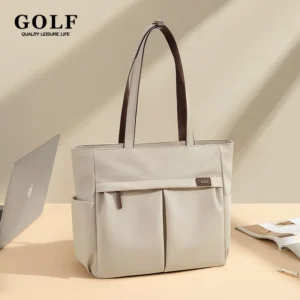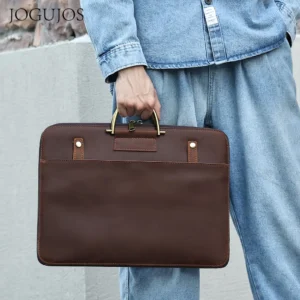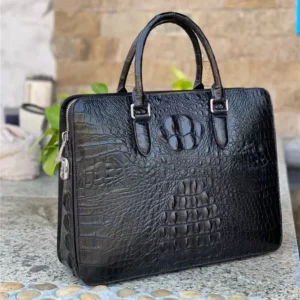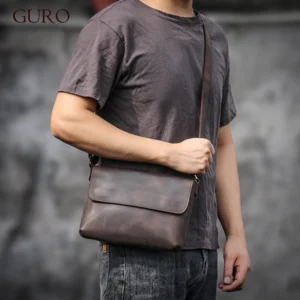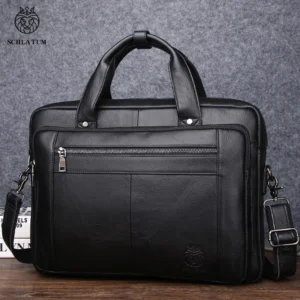Introduction: Leather Quality Fundamentals for Discerning Buyers
When investing in a premium leather bag, understanding quality differences becomes essential to making a wise purchase. Among the most critical decisions you’ll face is choosing between full grain and top grain leather—a choice that significantly impacts your bag’s appearance, longevity, and overall value.
Leather grade isn’t merely a technical specification; it fundamentally determines how your bag will perform over years of use, develop character with age, and retain its beauty through daily wear. The difference between these premium leather types goes far beyond price tags—though full grain typically commands a higher investment than top grain alternatives.
In this comprehensive guide, we’ll explore the distinctive qualities of full grain and top grain leather, helping you understand which option best aligns with your needs, preferences, and lifestyle. By understanding the nuances of choosing timeless classic leather briefcases, you’ll be equipped to make an informed decision that serves you well for years to come.
Quick Comparison: Full Grain vs. Top Grain at a Glance
Before diving into the details, let’s examine how these two premium leather types compare across key characteristics:
| Feature | Full Grain Leather | Top Grain Leather |
|---|---|---|
| Source | Outermost layer of hide with natural surface intact | Outermost layer with top surface sanded/buffed |
| Surface Appearance | Natural, includes visible pores and markings | Uniform, consistent, fewer visible natural variations |
| Durability | Exceptional (20+ years with proper care) | Very good (10-15 years with proper care) |
| Patina Development | Rich, distinctive aging that enhances character | Limited aging, more consistent appearance over time |
| Tactile Feel | Initially firmer, develops suppleness with use | Softer and more pliable from the start |
| Breathability | Excellent | Good but slightly reduced |
| Price Range | Premium (highest quality tier) | Mid-to-high range (second highest tier) |
| Best Uses | Heirloom pieces, daily-use items, statement bags | Professional settings, fashion-forward designs, versatile use |
Understanding these fundamental differences helps establish a foundation for defining best leather briefcases that meet your specific needs.
Leather Grades Explained: Positioning Full and Top Grain in the Quality Spectrum
To fully appreciate the comparison between full grain and top grain leather, it’s helpful to understand the entire leather quality hierarchy:
- Full Grain: The highest quality leather that retains the hide’s natural outer surface with minimal processing
- Top Grain: The second highest quality, where the uppermost surface is sanded to remove imperfections
- Split/Genuine Leather: Lower layers of hide after the top portions are removed
- Bonded Leather: Manufactured material made from leather scraps bonded together with adhesives
One common misconception involves “genuine leather”—a term that sounds positive but actually indicates a lower-quality product in the leather hierarchy. This marketing terminology often misleads consumers into believing they’re purchasing premium leather.
Both full grain and top grain represent the upper echelon of leather quality, sourced from the strongest and most desirable portion of the hide. These premium grades stand apart from other options because they maintain the natural strength of the leather’s fiber structure, albeit in different ways.
The leather-making process involves numerous steps from raw hide to finished product, including cleaning, tanning, and finishing—with the primary difference between our featured grades occurring in the surface treatment stage. Understanding leather quality full grain vs top grain distinctions helps appreciate why these materials command premium prices compared to other options.
Full Grain Leather: Nature’s Premium Material
Full grain leather represents the pinnacle of leather quality, maintaining the hide’s natural outer surface in its original state. This grade undergoes minimal processing, preserving the natural grain pattern, pores, and even minor imperfections that tell the story of the animal’s life.
What makes full grain exceptional is its intact fiber structure. The uppermost portion of the hide features densely packed fibers that provide remarkable strength and durability. This natural density creates a material that resists tearing and maintains its structural integrity even after years of regular use.
The untouched surface of full grain leather showcases distinctive natural markings—small scars, wrinkles, and subtle variations in texture. Rather than being viewed as flaws, these characteristics are prized by leather connoisseurs as evidence of authenticity and uniqueness. Each full grain leather product tells its own story through these natural features, ensuring no two pieces are exactly alike.
The benefits of full-grain leather bags extend far beyond their visual appeal, offering functional advantages that justify their position at the premium end of the leather spectrum.
The Advantages of Full Grain Leather for Bags
Full grain leather offers several significant benefits that make it particularly well-suited for high-quality bags:
Exceptional Longevity: With proper care, full grain leather bags often last 25+ years, with many becoming family heirlooms passed between generations. This remarkable durability comes from the intact, dense fiber structure that resists wear.
Beautiful Patina Development: Perhaps the most cherished quality of full grain leather is how it ages. Rather than deteriorating, it develops a rich patina—a warm luster and deepening of color that makes the bag more beautiful over time. This natural aging process means your bag looks better after years of use than when new.
Unmatched Character: Each full grain piece features unique natural markings that tell a story. Many vintage full grain messenger bags become more treasured over time as they develop distinctive wear patterns reflecting their owner’s life and travels.
Superior Breathability: The natural, unaltered surface allows the leather to “breathe,” regulating moisture and adapting to environmental conditions. This quality helps prevent the growth of bacteria and maintains comfort during use.
Natural Strength: The unaltered grain layer provides outstanding resistance to stretching and tearing, ensuring your bag maintains its shape and functionality even under heavy loads or harsh conditions.
These qualities make full grain leather the preferred choice for premium bags meant to last for decades while developing distinctive character.
The Limitations of Full Grain Leather
Despite its many virtues, full grain leather does have some limitations worth considering:
Higher Price Point: The superior quality comes at a cost—typically 30-50% more than top grain alternatives. This premium reflects both the limited supply of suitable hides and the craftsmanship required to work with this demanding material.
Natural Imperfections: The very marks and variations that enthusiasts appreciate may not appeal to everyone. Those seeking perfectly uniform appearance might find the natural variations distracting.
Break-in Period: Full grain leather often begins quite firm and requires a breaking-in period before achieving optimal comfort and flexibility. This process can take weeks or even months of regular use.
Visibility of Wear: Water spots, stains, and scratches tend to be more visible on full grain leather, especially initially. While these eventually blend into the developing patina, some users may find this early visibility concerning.
Maintenance Requirements: Keeping full grain leather in optimal condition requires more attentive care, including regular conditioning to prevent drying and cracking.
Top Grain Leather: Refined Elegance and Practicality
Top grain leather represents the second-highest quality tier in the leather hierarchy, offering an excellent balance between durability and refined appearance. This grade undergoes a specific processing technique where the outermost surface of the hide is sanded or buffed to remove natural imperfections and irregularities.
This sanding process serves multiple purposes: it eliminates surface blemishes, creates a more uniform appearance, and reduces thickness for increased pliability. After sanding, top grain leather typically receives a light surface coating that enhances stain resistance and provides more consistent coloration.
The finishing processes applied to top grain leather often include treatments to add texture (sometimes mimicking natural grain patterns) and protective elements that shield against moisture and everyday wear. These treatments contribute to a leather that requires less initial breaking-in and maintains a more consistent appearance throughout its life.
While the processing does remove the densest portion of the hide’s fiber structure, top grain leather remains substantially durable, retaining much of the strength that makes leather desirable for quality bags. The top grain leather briefcase durability remains impressive even with these modifications.
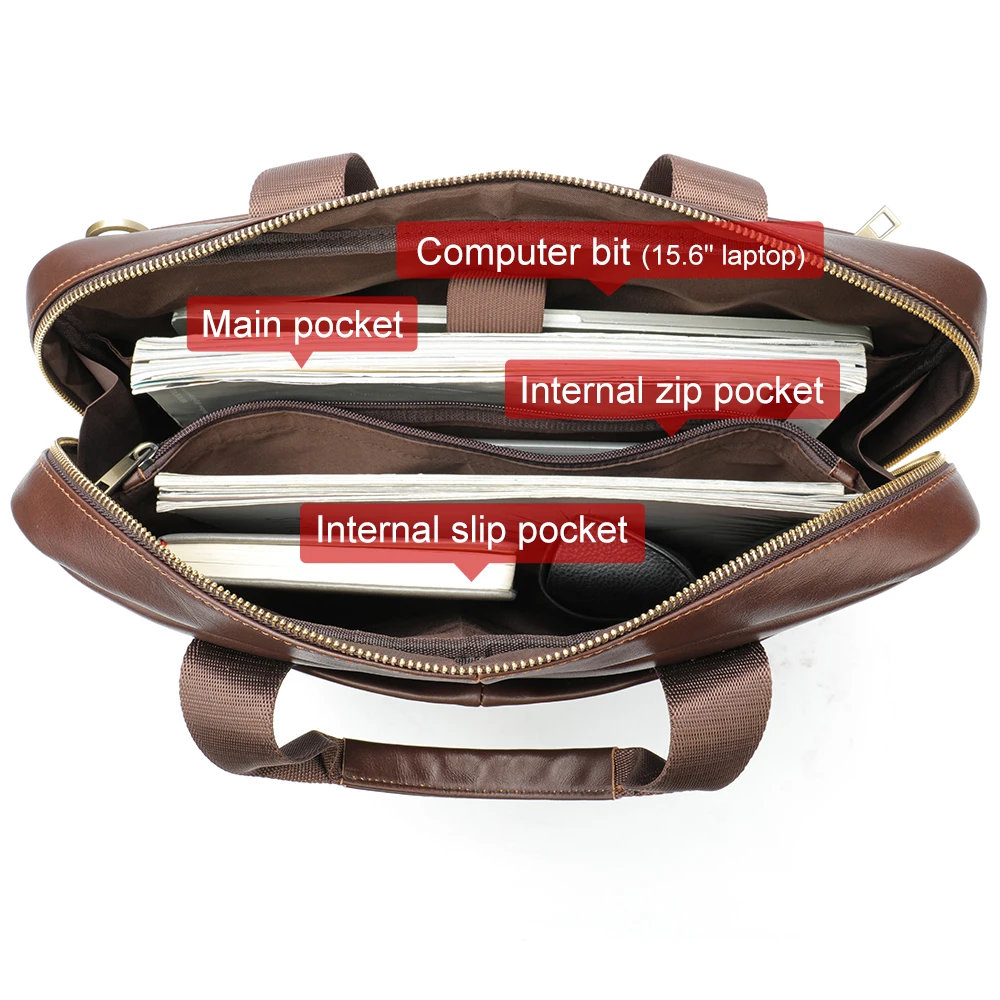
The Advantages of Top Grain Leather for Bags
Top grain leather offers distinct benefits that make it an excellent choice for many bag styles:
Attractive Price-to-Quality Ratio: Top grain provides exceptional value, delivering 80-90% of full grain’s durability at a significantly lower price point, making quality leather bags more accessible.
Consistent, Refined Appearance: The processing creates a uniform surface that presents a polished, professional aesthetic ideal for formal business environments where consistency matters.
Immediate Suppleness: Unlike full grain leather that requires breaking in, top grain leather feels soft and flexible from day one, offering immediate comfort without the adjustment period.
Enhanced Stain Resistance: The surface treatments applied during processing provide better protection against spills, making top grain leather more forgiving in everyday situations and easier to maintain.
Versatile Color Options: The sanding process allows top grain leather to accept dyes more evenly, enabling a wider range of consistent color options beyond the natural tones typical of full grain leather.
These characteristics make top grain leather particularly well-suited for professional bags that need to maintain a polished appearance in varied environments.
The Limitations of Top Grain Leather
While excellent in many respects, top grain leather does have some limitations compared to full grain:
Reduced Longevity: Though still quite durable, top grain typically lasts 10-15 years with proper care—impressive but shorter than full grain’s multi-decade potential.
Limited Patina Development: The surface treatments that enhance uniformity also restrict the leather’s ability to develop the rich patina prized in full grain leather. Top grain tends to age more subtly.
Less Character Development: The processed surface means top grain leather won’t develop the same distinctive character over time, maintaining a more consistent appearance throughout its lifespan.
Somewhat Reduced Breathability: Surface treatments slightly diminish the leather’s natural ability to breathe, though this difference is minor for most users.
Potential for Surface Wear: With heavy use, the protective finish can eventually wear unevenly, particularly at stress points or edges, requiring more careful handling over time.
Side-by-Side Comparison: Critical Factors for Bag Buyers
When evaluating leather bags for purchase, several key factors deserve special attention:
Durability Differences
The durability gap between these leather types stems primarily from fiber structure. Full grain retains the densest, strongest fiber arrangement found naturally in hide, providing superior resistance to wear and tear. Top grain, having lost its uppermost layer to sanding, sacrifices some structural integrity in exchange for refinement. However, this difference becomes most apparent only after many years of use—both options far outperform lower leather grades.
Aging Characteristics
Perhaps the most significant practical difference lies in how these leathers age. Full grain develops what enthusiasts call a patina—a rich, lustrous character that emerges through exposure to natural oils, sunlight, and handling. This patina creates depth and unique character, making the bag more beautiful as it ages. Top grain leather, while aging gracefully, changes more subtly due to its protective surface treatments. It maintains its original appearance longer but foregoes some of the character development that makes full grain so distinctive over time.
Tactile Experience
The feeling of your bag against your hand creates a daily sensory experience worth considering. Full grain leather typically begins firm and gradually softens, developing a warm, natural feel that molds to your handling patterns. Top grain offers immediate suppleness and a smoother, more consistent texture from the beginning. This difference in tactile qualities affects not just how the bag feels but how you interact with it daily.
Weather Performance
Both leather types can handle occasional moisture exposure when properly maintained, but they respond differently. Full grain leather may show water spots more readily but, when properly conditioned, has natural water-resistant properties. Top grain’s surface treatments provide better initial protection against light moisture but may require more frequent reapplication of protective products to maintain this advantage over time.
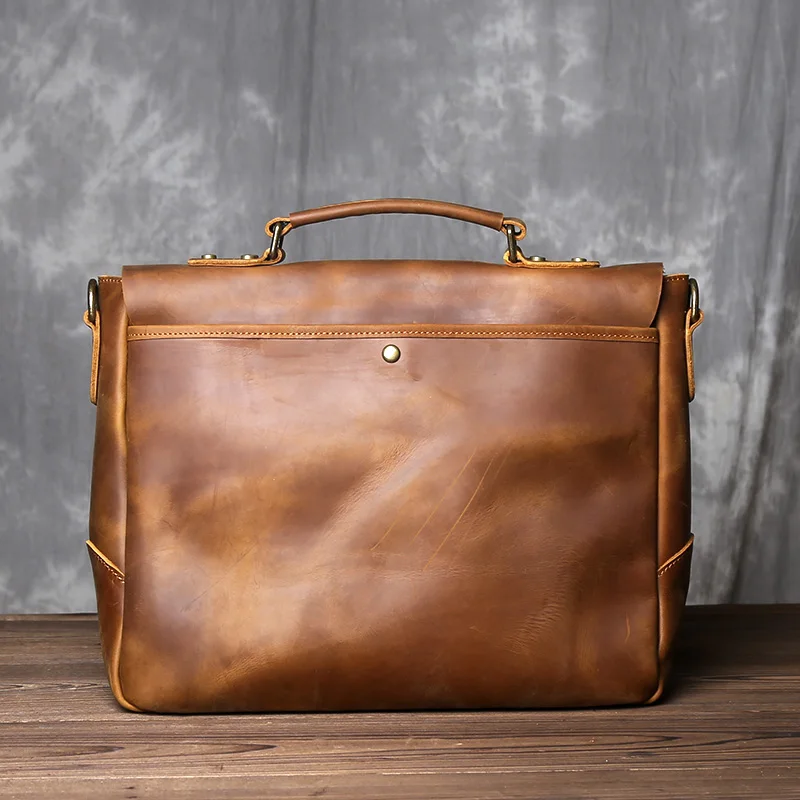
Making Your Decision: Matching Leather Type to Your Needs
Choosing between full grain and top grain leather becomes easier when you align your selection with your specific priorities and use case. Consider these key factors when making your decision:
Investment Timeline: How long do you expect to use this bag? For decades-long use, full grain’s superior longevity justifies its higher price. For 5-10 year horizons, top grain offers better value.
Aesthetic Preference: Do you prefer items that develop unique character with age, or do you value consistent appearance? Full grain evolves dramatically while top grain maintains its original look longer.
Usage Environment: Will your bag face harsh conditions and heavy use, or serve in more protected professional settings? Full grain withstands rugged conditions better, while top grain excels in environments where appearance matters most.
Maintenance Willingness: Are you committed to regular leather care, or do you prefer lower maintenance requirements? Full grain rewards careful maintenance with extraordinary longevity, while top grain forgives occasional maintenance lapses better.
Understanding how choose perfect leather briefcase involves honest assessment of these personal factors rather than just considering abstract quality metrics.
Recommended Uses for Full Grain Leather Bags
Full grain leather particularly excels in these applications:
Daily workhorses: For the bag you’ll carry five days a week for years, full grain’s durability and improving appearance with age make it ideal.
Travel companions: Bags that will face varying conditions, occasional rough handling, and constant use benefit from full grain’s superior resilience.
Heritage items: When purchasing a bag you hope might someday be passed down, full grain’s multi-decade lifespan makes it the appropriate choice.
Character-focused pieces: For those who appreciate how leather tells a story through developing patina, full grain offers the richest narrative.
Statement investments: When the bag represents a significant purchase that showcases your appreciation for craftsmanship, full grain delivers the premium experience.
Many professionals find mens classic leather briefcases in full grain leather provide the perfect balance of professional presentation and lasting quality.
Recommended Uses for Top Grain Leather Bags
Top grain leather shines in these scenarios:
Professional environments: When consistent, refined appearance matters daily, top grain’s uniform look maintains a polished impression.
Fashion-conscious selections: For bags where current style matters as much as durability, top grain offers excellent quality with more design flexibility.
Rotation pieces: Bags used in a rotation with other items benefit from top grain’s lower maintenance needs during storage periods.
Value-focused purchases: When seeking the best quality-to-price ratio, top grain often represents the sweet spot in the leather market.
Immediate satisfaction: For those who prefer products that feel broken-in from day one, top grain’s initial softness provides immediate comfort.
For professionals needing functional elegance, leather laptop work totes in top grain leather offer an excellent combination of practicality and refined appearance.
Men's Classic Leather Briefcase, Slim Leather Laptop Briefcase, Slim Leather Portfolio Briefcase
$93.67 Select options This product has multiple variants. The options may be chosen on the product pageLeather Laptop Work Tote, Tan Leather Work Tote, Women's Leather Work Tote, Zippered Leather Work Tote
Price range: $223.62 through $237.97 Select options This product has multiple variants. The options may be chosen on the product pageClassic Laptop Briefcase, Men's Classic Leather Briefcase, Slim Leather Attache Case
Price range: $353.50 through $360.81 Select options This product has multiple variants. The options may be chosen on the product pageBlack Leather Briefcase, Leather Document Bag, Men's Classic Leather Briefcase
Genuine Crocodile Leather Executive Briefcase with Password Lock – Premium Business Document Carrier$1,201.87 Select options This product has multiple variants. The options may be chosen on the product pageCrazy Horse Leather Satchel, Men's Leather Satchel, Men's Professional Leather Messenger, Vintage Style Messenger Bag
$132.70 Select options This product has multiple variants. The options may be chosen on the product pageBlack Leather Briefcase, Classic Laptop Briefcase, Men's Classic Leather Briefcase, Slim Leather Laptop Briefcase
$228.72 Select options This product has multiple variants. The options may be chosen on the product page
Essential Care Guide: Maintaining Your Leather Investment
Proper maintenance significantly extends the life of both leather types, though with some important differences:
For Both Leather Types:
– Store in dust bags when not in use
– Keep away from direct sunlight and heat sources
– Clean spills promptly with a dry cloth
– Allow wet bags to dry naturally away from heat
– Avoid overloading that might strain seams and handles
For Full Grain Leather:
– Condition every 3-6 months with quality leather conditioner
– Use minimal product and focus on even application
– Embrace minor scratches as they contribute to patina development
– Consider occasional application of leather cream to nourish deeply
For Top Grain Leather:
– Clean surface with appropriate leather cleaner every 4-6 months
– Apply leather protector to maintain water and stain resistance
– Address edge wear with matching edge kote when needed
– Use conditioner somewhat less frequently than with full grain
Learning how maintain leather briefcase properly ensures your investment will serve you well regardless of which leather type you choose.
Beyond the Basics: Other Leather Terms You Might Encounter
When shopping for leather bags, you may encounter these additional terms worth understanding:
Aniline vs. Semi-Aniline: Aniline leather uses only dye without surface pigments, showing natural variations. Semi-aniline adds a light protective topcoat while still showcasing natural grain.
Vegetable Tanning vs. Chrome Tanning: Vegetable tanning uses plant materials for a traditional, environmentally friendly process that creates rich patina over time. Chrome tanning uses chromium salts for a faster, more water-resistant result.
Corrected Grain: This term indicates that the leather has been more heavily processed to remove flaws, often with an artificial grain pattern embossed afterward.
Pull-Up Leather: A full or top grain leather with oils and waxes that lighten in color when bent or stretched, creating a visual depth effect.
Be wary of vague terms like “genuine leather” or “real leather” without specific grade information—these often indicate lower quality despite sounding premium.
The Verdict: Quality Leather for Lasting Impressions
When comparing full grain and top grain leather bags, the decision isn’t simply about identifying the “better” option but rather determining which aligns with your specific needs and values. Full grain represents the pinnacle of leather quality, offering unmatched longevity and character development for those who appreciate leather that tells a story through its aging process. Top grain provides excellent quality with more immediate refinement and consistency at a more accessible price point.
Both options represent significant upgrades from lower leather grades, offering the durability and presence that only quality leather can provide. The key to satisfaction lies in matching your choice to your priorities—whether you value the evolving character of full grain or prefer the consistent elegance of top grain.
Regardless of which leather type you select, proper care remains essential to maximizing its potential lifespan. A well-maintained top grain bag will outlast a neglected full grain piece, making your commitment to maintenance as important as your initial selection.
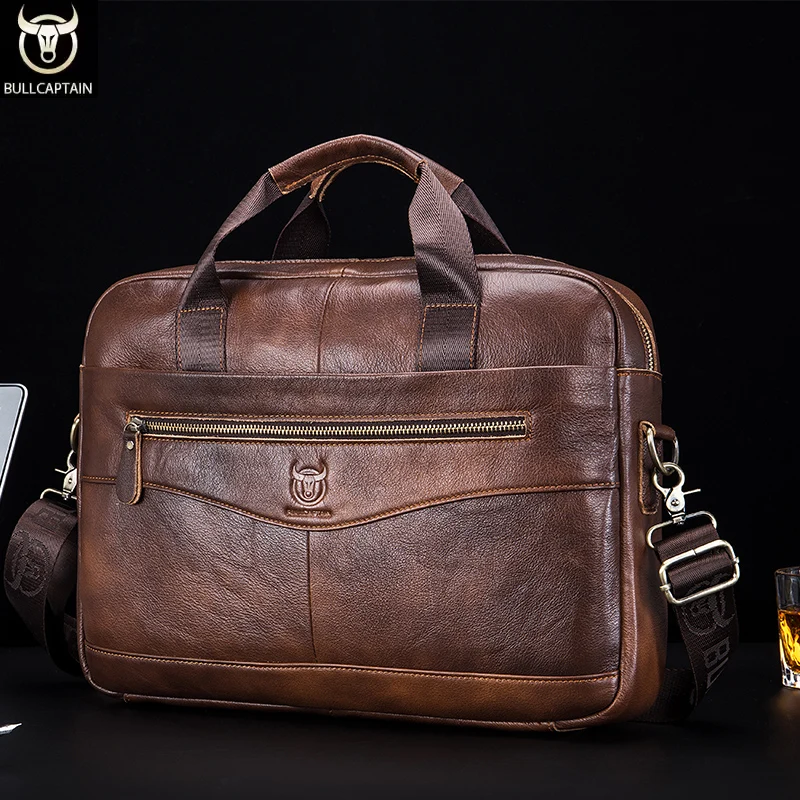
The classic leather briefcases that earn compliments and serve faithfully for years come in both leather types—the best choice is the one that fits your lifestyle, budget, and appreciation for how leather performs over time.
How Can You Identify Quality Leather When Shopping?
Identifying quality leather requires engaging multiple senses:
Smell: Quality leather has a distinct natural aroma. Strongly chemical smells often indicate excessive processing or synthetic materials.
Touch: Quality leather feels supple but substantial. It should warm to your touch and have a smooth, not plastic-like surface.
Appearance: Look for depth of color rather than perfectly uniform surface. Examine edges—quality pieces have clean, often painted or burnished edges rather than rough cuts.
Response to Touch: Quality leather should develop a temporary darker mark when you run your fingernail lightly across it, showing its natural response to oils.
Ask retailers specific questions about the leather source, tanning method, and grade. Quality manufacturers willingly provide these details while vague responses often indicate lower quality products.
For distinctive character in premium leather, many professionals select crazy horse leather satchels which showcase leather’s natural beauty.
Do Full Grain and Top Grain Leathers Require Different Maintenance Routines?
The maintenance needs for these leather types differ in several important ways:
Full grain leather benefits from more frequent conditioning—typically every 3-4 months—to nourish the exposed natural fibers and prevent drying. Products containing natural waxes and oils work best for this leather type.
Top grain leather requires conditioning less frequently—often every 6 months—but benefits from occasional application of protective sprays to maintain its surface treatment. Cleaning products formulated specifically for finished leathers work best.
Both leather types should be cleaned differently as well. Full grain responds best to minimal product and gentle handling that preserves its developing patina. Top grain can handle more direct cleaning with appropriate leather cleaners.
The most common maintenance mistake is over-conditioning full grain leather, which can saturate the fibers and create a tacky surface. With top grain, the common error is using products designed for unfinished leather that may damage the protective coating.
Is the Price Premium for Full Grain Leather Justified for Everyday Bags?
When considering the investment in full grain leather, calculating “cost per wear” provides helpful perspective. A $500 full grain briefcase used weekly for 20 years costs approximately $0.50 per use—often less than a daily coffee.
Beyond pure economics, full grain offers intangible benefits including the pleasure of using materials that improve with age—a rarity in our disposable culture. Many owners report greater satisfaction as their full grain bag develops character over years.
For daily-use items like work bags, the durability advantage of full grain becomes most apparent. These pieces absorb daily friction, weight stress, and exposure that quickly deteriorate lesser materials.
The “buy fewer, better things” philosophy applies perfectly to leather goods. One exceptional full grain bag often outlasts several lower-quality alternatives, reducing long-term cost while providing superior daily experience.
For those who appreciate craftsmanship and materials that tell a story, the premium for full grain represents not just a practical investment but an aesthetic one—choosing an item that becomes more distinctly yours with each passing year.



